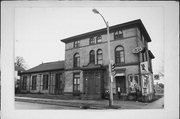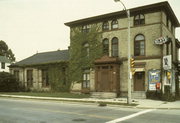Property Record
1702 N Vel R. Phillips Ave (AKA 1702 N 4TH ST)
Architecture and History Inventory
| Historic Name: | Miss E. Baasen House/German YMCA |
|---|---|
| Other Name: | Wisconsin House Tavern |
| Contributing: | Yes |
| Reference Number: | 16827 |
| Location (Address): | 1702 N Vel R. Phillips Ave (AKA 1702 N 4TH ST) |
|---|---|
| County: | Milwaukee |
| City: | Milwaukee |
| Township/Village: | |
| Unincorporated Community: | |
| Town: | |
| Range: | |
| Direction: | |
| Section: | |
| Quarter Section: | |
| Quarter/Quarter Section: |
| Year Built: | 1874 |
|---|---|
| Additions: | 1912 1889 1907 |
| Survey Date: | 2004 |
| Historic Use: | house |
| Architectural Style: | Italianate |
| Structural System: | |
| Wall Material: | Cream Brick |
| Architect: | Charles A. Gombert; Cornelius Leenhouts and Hugh Wilson Guthrie |
| Other Buildings On Site: | |
| Demolished?: | No |
| Demolished Date: |
| National/State Register Listing Name: | Baasen House-German YMCA |
|---|---|
| National Register Listing Date: | 8/2/1984 |
| State Register Listing Date: | 1/1/1989 |
| National Register Multiple Property Name: | Multiple Resources of N. 3rd St. - Brewers' Hill |
| Additional Information: | The M in the photo code stands for Milwaukee. UTM Reference: 16/425, 540/4766? ARCHITECTURAL STATEMENT: The building is a three-story masonry design with a one-story gable roofed wing extending to the north; this is a 44' x 48' brick veneer addition. The building is executed in Milwaukee "cream city" brick. It is located on the corner of North Fourth and West Walnut Streets, incorporating both flat and round arch window openings. The west front elevation of the three-story portion is a symmetrical arrangement with a center entry and flanking linteled window. Openings are repeated directly above those on the ground reflecting the wider entry opening below. The facade is split horizontally into discernible floors by belt courses extending around the builidng. A wide overhanging cornice shelters the shorter third floor windows. The entry is projected out from the building and executed in wood, including a flat roof with a half-round topped parapet. The one-story portion has tall pairs of double-hung window sashes alternating between pilasters which divide it into four bays. The interior has undergone extensive alteration. A gymnasium addition was constructed in 1889; a third floor was added in 1907 and the gymnasium was converted into a hospital. First floor partitions were removed in 1933 to allow for a tavern. The Walnut Street Front had been adapted into storefronts in the 1930's. (1982 photo 25/1). The Baasen House is an architecturally interesting example of the Italian Villa design in the area. Such residences were more associated with the City's Yankee Hill area and the development along West Wisconsin Avenue. Situated prominently at the intersection of two streets (North Fourth and East Walnut), it is one of the few brick residences constructed in Brewers' Hill at that time. Designed by architect Charles A. Gombert, for $3,500, fhe was proficient in many styles and is most well known for his Gothic Water Tower (of 1873) on the bluff at the City's east side. In the"Sentinel's" yearly architectural surveys, Gombert appears among the list of ten most active architects throughout the 1880s. HISTORICAL STATEMENT: The Baasen House is significant because it is associated with the social and religious development of Brewers' Hill. The building was constructed in 1874 as a residence for John F. Baasen, a prominent early citizen of Milwaukee. He served as one of the directors of the Milwaukee-Horicon Railroad and the Berlin and Lake Superior Railroad. Baasen was influential in getting the Capuchin Monastery of St. Francis of Asssissi extablished in the area. (See historical statement St. Francis of Assisi Complex). He also was one of three residents who collected signatures and petitioned for the organization of St. Francis parish on the monastery grounds. Baasen died in 1874 at the age of 80, as one of the oldest settlers in the community. His wife Mary Sibylla Baasen died in 1878 and the house became the property of his daughter Elise. Ms. Baasen remained a member of the St. Francis Parish and contributed to church furnishings and participated in various church organizations. By 1883, Ms. Baasen and her borther Michael A. J. Baasen moved out of the house and into a dwelling immediately to the east. The headquarters of the German Branch of the YMCA were located in the house from 1888 to 1893. The German Branch was formalized as part of the Youngmen's Christian Association in January, 1881 after several years of informal association. Their activities were centered around the old La Crosse Depot at 340 Third Street until 1883. After several years of fundraising, they were able to acquire the former Baasen House and convert it into their headquarters. In 1889, the single-story wing to the north was added and served as their gymnasium. In 1893, it was decided to discountinue activities out of this location. The German Branch as a whole was discontinued and the members were transferred to the central association. The house was then leased by the YMCA to the House of Mercy for use in its philanthropic activities. From 1905 to 1912 the Mt. Sinai Hospital used the building. Mt. Sinai was organized by prosperous Jewish citizens to serve the needs of the poor Russian and Eastern European Jews were were beginning to settle in large numbers in the area. A 1907 alteration raised the roof and aded the present third floor. In 1919 the building became the Wisconsin House Hotel. Through the 1930s, the Walnut Street side was occupied by several shops including ladies' apparel, a restaurant, a cigar store and a photo studio. It was first used as a tavern in 1933 by owner Joe Kersher. Previously surveyed in 1982 with a map code of 25/1 on a Historic Brewers Hill Map |
|---|---|
| Bibliographic References: | [A]. Conard, Howard Louis. "History of Milwaukee County." Vol. II. Chicago: American Biographical Publishing Company, No Date. [B]. Tax Program. [C]. Building Permits. [D]. City Directories. Voyageur magazine, Vol. 17, #1, Summer/Fall 2000, p. 53. |
| Wisconsin Architecture and History Inventory, State Historic Preservation Office, Wisconsin Historical Society, Madison, Wisconsin |


